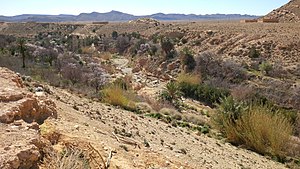

Deserts and xeric shrublands are a biome defined by the World Wide Fund for Nature. Deserts and xeric (Ancient Greek ξηρός xērós 'dry') shrublands form the largest terrestrial biome, covering 19% of Earth's land surface area. Ecoregions in this habitat type vary greatly in the amount of annual rainfall they receive, usually less than 250 millimetres (10 in) annually except in the margins. Generally evaporation exceeds rainfall in these ecoregions. Temperature variability is also diverse in these lands. Many deserts, such as the Sahara, are hot year-round, but others, such as East Asia's Gobi Desert, become quite cold during the winter.
Temperature extremes are a characteristic of most deserts. High daytime temperatures give way to cold nights because there is no insulation provided by humidity and cloud cover. The diversity of climatic conditions, though quite harsh, supports a rich array of habitats. Many of these habitats are ephemeral in nature, reflecting the paucity and seasonality of available water. Woody-stemmed shrubs and plants characterize vegetation in these regions. Above all, these plants have evolved to minimize water loss. Animal biodiversity is equally well adapted and quite diverse.
Degradation
Desertification
Main article: Desertification
The conversion of productive drylands to desert conditions, known as desertification, can occur from a variety of causes. One is human intervention, including intensive agricultural tillage or overgrazing in areas that cannot support such exploitation. Climatic shifts such as global warming or the Milankovitch cycle (which drives glacials and interglacials) also affect the pattern of deserts on Earth.
Woody plant encroachment
Main article: Woody plant encroachmentXeric shrublands can experience woody plant encroachment, which is the thickening of bushes and shrubs at the expense of grasses. This process is often caused by unsustainable land management practices, such as overgrazing and fire suppression, but can also be a consequence of climate change. As a result, the shrublands' core ecosystem services are affected, including its biodiversity, productivity, and groundwater recharge. Woody plant encroachment can be an expression of land degradation.
Ecoregions
See also: List of desert and xeric shrubland ecoregionsThe World Wide Fund for Nature highlights a number of desert ecoregions that have a high degree of biodiversity and endemism:
- The Nama Karoo of Namibia has the world's richest desert fauna.
- The Chihuahuan desert and Central Mexican matorral are the richest deserts in the Neotropics.
- The Carnarvon xeric shrublands of Australia are a regional center for endemism.
- The Sonoran and Baja deserts of Mexico are unusual desert communities dominated by giant columnar cacti.
- Madagascar spiny forests
- Atacama Desert
See also
- Hydric soil – soil typePages displaying wikidata descriptions as a fallback
- Mesic – Habitat with a moderate supply of moisture
- Rain shadow – Leeward side of a mountain range
- Sagebrush steppe – Grassland ecosystem
- Shrub-steppe – Arid grasslandPages displaying short descriptions of redirect targets
- Temperate grasslands, savannas, and shrublands – Terrestrial biome
- Xeriscaping — gardening or landscaping in xeric environments
- Xerocoles — animals adapted to xeric environments
- Xerophytes — plants adapted to xeric environments
References
- ^
 This article incorporates text available under the CC BY-SA 3.0 license. World Wide Fund for Nature. "Deserts and Xeric Shrubland Ecoregions". Archived from the original on 2012-04-25. Retrieved 2019-05-29.
This article incorporates text available under the CC BY-SA 3.0 license. World Wide Fund for Nature. "Deserts and Xeric Shrubland Ecoregions". Archived from the original on 2012-04-25. Retrieved 2019-05-29.
- Lockwood, M. Managing Protected Areas: A Global Guide. p. 199.
- "Nama Karoo". WWF. Retrieved 2018-12-19.
- Hogan, C. Michael (2009). "Overgrazing". In Draggan, Sidney; Cleveland, Cutler J. (eds.). Encyclopedia of Earth. Washington, D.C.: National Council for Science and the Environment.
- Eldridge, David J.; Bowker, Matthew A.; Maestre, Fernando T.; Roger, Erin; Reynolds, James F.; Whitford, Walter G. (July 2011). "Impacts of shrub encroachment on ecosystem structure and functioning: towards a global synthesis: Synthesizing shrub encroachment effects". Ecology Letters. 14 (7): 709–722. doi:10.1111/j.1461-0248.2011.01630.x. PMC 3563963. PMID 21592276.
- Archer, Steven R.; Andersen, Erik M.; Predick, Katharine I.; Schwinning, Susanne; Steidl, Robert J.; Woods, Steven R. (2017), Briske, David D. (ed.), "Woody Plant Encroachment: Causes and Consequences", Rangeland Systems, Springer Series on Environmental Management, Cham: Springer International Publishing, pp. 25–84, doi:10.1007/978-3-319-46709-2_2, ISBN 978-3-319-46707-8, S2CID 133015720
- Schlesinger, William H.; Reynolds, James F.; Cunningham, Gary L.; Huenneke, Laura F.; Jarrell, Wesley M.; Virginia, Ross A.; Whitford, Walter G. (1990-03-02). "Biological Feedbacks in Global Desertification". Science. 247 (4946): 1043–1048. Bibcode:1990Sci...247.1043S. doi:10.1126/science.247.4946.1043. ISSN 0036-8075. PMID 17800060. S2CID 33033125.
- Cowling, RM; Hilton-Taylor, C (1994). "Patterns of plant diversity and endemism in southern Africa: An overview". In Huntley, BJ (ed.). Botanical diversity in southern Africa. Pretoria, South Africa: National Botanical Institute. pp. 31–52.
- Hernandez, HM; Barcenas, RT (1995). "Endangered cacti in the Chihuahuan Desert: I. Distribution patterns". Conservation Biology. 9 (5): 1176–1188. doi:10.1046/j.1523-1739.1995.9051169.x-i1. PMID 34261239.
External links
- Index to Deserts & Xeric Shrublands at bioimages.vanderbilt.edu
- Xeric World Online community focused on the study of xeric plant species
- Desert Plants: List, Names and Adaptations
| Biogeographic regionalisations | |||||||||||||||||
|---|---|---|---|---|---|---|---|---|---|---|---|---|---|---|---|---|---|
| Biomes |
| ||||||||||||||||
| Biogeographic realms |
| ||||||||||||||||
| See also | |||||||||||||||||